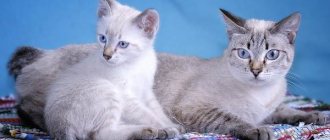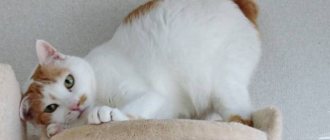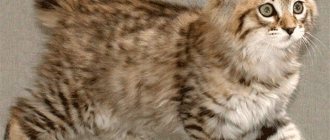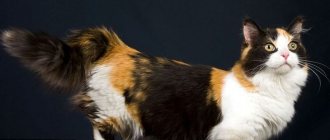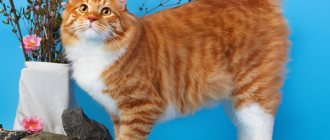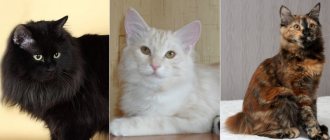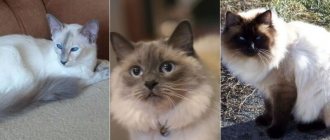Representatives of the Mekong or Thai Bobtail breed are true aristocrats among their brothers. They came to us from Asia. Ancient images have been preserved in which cats are dressed in the “decorations” of the Siamese princesses. They are similar in appearance to them in the dark color of the muzzle, but they differ from this breed - loops and kinks on the tail. The peculiarity of the animals is the similarity of their character with that of a dog: they walk on a leash, are easily taught commands and can fetch things in their teeth.
Story
The breed is one of the most ancient, and therefore there are legends and myths accompanying it.
One of them says that in ancient times beautiful princesses lived in Siamese temples and their pets were cats with broken tails and dark muzzles. While taking a bath, they took off their magnificent jewelry and put it on the tails of their guardians - Siamese with broken tails. And they took special care of their entrusted treasures.
Read a separate article about the Siamese cat breed, see their photos on our Mister Cat portal.
Representatives of this breed first came to European countries in 1884 from the capital of Siam with the poetic name City of Angels. They were brought to America several years later, and in Russia they appeared at the court of the emperor at the beginning of the 20th century.
Due to the broken tail in numerous knots, the breed was not recognized by felinologists in many countries for a long time and they were not allowed to participate in exhibitions, as this was considered a defect.
However, Russian breeders fell in love with the animals, and they made a lot of efforts to preserve the breed. At that time these animals were called Thai. By crossing the Mekong with other varieties of cats brought from Southeast Asia, it was possible to expand it.
In 1994, the Mekong standard was first adopted by the WCF, and in 2003, 30 individuals that differed significantly from the Thai Bobtail were submitted to the organization for evaluation. Based on the results, it was decided to separate these cats into a separate breed, which was called the Mekong Bobtail.
Brief history of the breed
The homeland of the Mekong is considered to be Southeast Asia, and their first description is found in Charles Darwin’s work “Change in Domestic Animals and Cultivated Plants,” dated 1883. Initially, they lived in temples and imperial palaces and were not exported outside the state for a long time.
Foreigners could only take possession of a Mekong cat as a valuable gift. The list of recipients included such famous personalities as British Ambassador Owen Gould, Nicholas II and the governess of the children of the ruler of Siam, Anna Crawford.
European felinologists learned about the Mekong in 1884. Cats of this breed came to the USA only in the 1890s. For a long time, the Mekong Bobtail was considered a variety of Siamese and was discarded due to its broken short tail. This anatomical feature was preserved only thanks to individual connoisseurs of Thai bobtails. After some time, experts noticed that Mekongs differ from Siamese not only in the length of their tail, but also in their build and set of ears.
Purposeful breeding of the breed began only in the 20th century. Russian felinologists played an important role in the development of the Mekong. In 1994, O. S. Mironova submitted the first breed standard for consideration at the WCF training camp in St. Petersburg.
The final registration of the Mekong Bobtail took place in 2004 at the August meeting of the WCF General Assembly, which was held in the German city of Essen.
Legends
The appearance of the animals - a broken spiral tail and slightly slanted eyes - has given rise to many legends about their origin:
- Southeast Asia is famous for its magnificent temples. The monks used cats as guards for ancient priceless temple vases. The animal wrapped its tail around them and carefully watched so that no one approached the vase. Over time, the tail acquired corresponding bends, and the eyes became slanted.
- The second legend tells about a fearless representative of the Mekong bobtail breed. The animal rushed in pursuit of the thieves who stole the king's golden cup. The cat was able to take the treasure. While waiting for help, she wrapped her tail around the cup for safety and sat in this position for several days. The precious vessel was safely returned to its owner, but the tail remained bent.
- The most popular version is about using curled ponytails as “storage” for royal jewelry. During bathing, princesses entrusted their jewelry to cats. Bracelets and rings on such a tail were never lost.
Interesting Facts
During the existence of the Mekongs, many interesting things have been associated with them:
- For a long time, these cats were not considered a separate breed and were called Thai Bobtails. Later they were renamed the Mekong, which is the name of the river near which they lived.
- In the old days, bobtails were considered sacred and lived in Buddhist temples. According to one legend, when cats of this breed guarded ancient vases and figurines, they wrapped their tails around them and squinted their eyes strongly to see everything that was happening around them. Sitting in one position for a long time caused the Mekong's eyes to become slanted and its tail to bend.
- According to another legend, bobtails were the guards of Thai princesses and accompanied them on walks. When high-ranking persons wanted to swim, they hung the jewelry they had taken from themselves on the hooked tails of the Mekongs.
Colors
The colors of the breed are very diverse, the most popular are:
- - a combination of sunny peach and red, point with the main peach - red point, expressive, perky bright and as if from rays of light. This is a rare color and therefore in demand.
- - precious mink fur with a pearl-gray tint - blue point. Provides the basis for the even rarer chocolate point.
- -Siamese or color-point, allowing all shades in addition to white. When born white, kittens begin to darken (face, ears, paws) within a matter of hours. The fur coat acquires a grayish-white or cream tint, further color changes continue until puberty.
- -tabby point, striped bobtail (points look like they were painted).
- - Seal Points are widespread, their body is a creamy delicate tone, contrasting with the paws with a triangle of ears and a nose triangle.
- - a rare tortie point. Tortoiseshell color obtained in 2011.
A unique pet of this species is the cat Iris (translated from English as rainbow). It is assumed that the resulting offspring will have a dozen different, most outlandish combinations for the Mekong.
Breed description, standards, appearance
The Mekong Bobtail is a compact, harmoniously built cat with well-developed muscles and a short, broken tail. A detailed description of the breed is presented in the 2004 standard.
Dimensions and weight
The Mekong Bobtail is a medium-sized cat with pronounced sexual dimorphism. The breed standard suggests that the average weight of a female is 2.5-3 kg. The weight of a male Mekong fluctuates between 3.5-4 kg.
Anatomical characteristics
Ideally, the Thai Bobtail should fit the following description:
- The head is wedge-shaped, neat, with rounded outlines, an oval muzzle, a developed lower jaw and a strong chin.
- The ears are large, slightly tilted back, and set high. The gap between them is slightly less than the width of the base of the shell.
- The eyes are large, expressive, oval. The Mekong Bobtail's iris is pigmented blue.
- The body is rectangular, graceful, with developed muscles, a straight back and a slightly raised croup.
- The limbs are slender, moderately long, with small oval paws. The Mekong Bobtail does not hide the claws on its hind legs and walks with a characteristic clattering sound.
- The tail is short, with varying degrees of flexibility. Consists of a set of knots, loops and hooks. The shortest tail length of the Mekong Bobtail is 3 vertebrae, the maximum is limited to 1/4 of the length of the body.
The tail of each representative of the Mekong Bobtail breed is unique and has unique features. It can bend in any direction and consists of an individual combination of creases.
Depending on their appearance, Mekong tails are conventionally divided into the following types:
- stump - a very short tail, formed by fused vertebrae;
- spiral – vertebrae, the number of which does not exceed 15 pieces, are connected into a spiral;
- panicle – up to 10 vertebrae, broken at an obtuse angle;
- pushed back - straight tail of 7 vertebrae, ending with a hook.
Color and coat type
The body of the Mekong Bobtail is covered with shiny, close-fitting fur, under which there is practically no down. The cat's short, elastic and smooth spine feels like silk to the touch.
The Mekong Bobtail standard allows only color-point (Siamese) color without spots or patterns. The most common colors found in the breed are:
- Seal point. The Mekong Bobtail with this color has a cream-colored coat, and the tail, muzzle and paws are dark brown.
- Tabby point. There are clearly defined stripes on the tail, mask and paws of the Mekong, and on the cat’s face there is always a dark mark in the shape of the letter “M”.
- Torty point. This rare tortoiseshell color is characteristic only of females.
- Red point. This color is a combination of a white background with a delicate peach tint and fiery red markings.
- Blue point. The Blue Point Mekong Bobtail has bluish-pink markings on a silver background.
- Chocolate point. These Mekongs have chocolate brown markings on their snow-white fur.
Possible breed defects
Serious disadvantages that affect the show career of the Mekong Bobtail:
- thick cheeks;
- large and round eyes;
- pronounced cheekbones;
- thick undercoat;
- sharp stop.
Defects in the presence of which the Mekong Bobtail is excluded from participation in exhibitions and excluded from the breeding program:
- absence of knots, loops, hooks and curvatures on the tail;
- very short or too long tail.
Color
Until 2005, only 3 colors were officially recognized:
- Seal point or classic Siamese color. The coat has a creamy to light brown tint. Darker spots (even black-brown) on the face, paws, ears and tail.
- Red point is the rarest. The coat has a peach tint, and the characteristic spots have a reddish tint.
- Tortie point is a tortoiseshell color.
Torty Point
In subsequent years, the popularity of the breed increased and, thanks to selection, several more colors appeared:
- blue point – the fur on the body has a silvery tint, and the points on the face, tail and paws are bluish-pink;
- chocolate point – white body, and chocolate-colored spots;
- tabby – the dark letter “m” is clearly visible on the forehead, and the spots are striped.
Tabby color
Nurseries who are keen on breeding are now breeding cats with lilac and golden fur.
Character and temperament
The Mekong Bobtail is a curious and outgoing cat. He accompanies his owners everywhere and takes part in all household chores. The talkative pet comments on everything that happens with purring and cooing sounds and loves to be addressed by name.
Despite being sociable, a cat of this breed is quite restrained and knows how to control itself, and does not tolerate too violent manifestations of emotions.
The Mekong Bobtail is very dog-like in character. He also loves to carry various objects in his teeth and always comes running to sniff the host’s guests. And in case of danger, the cat will defend itself not with its claws, but with the help of bites.
On a note. Mekongs tolerate car travel well. But when the “speed limit” they set is exceeded, the cats begin to protest loudly.
Mekongs get along well with children and are patient with their pranks. Cats are also loyal to other animals, with the exception of rodents, fish and birds.
Description and features
These cats are similar in color to a Siamese or Thai cat. They are characterized by the so-called point color. That is, the whole body is of a lighter tone than its protruding parts - the muzzle with ears, paws and tail. They are colored much more intensely, for which they received the name “color point” - “color points” (from English “colored dots, marks”).
This coloring depends on temperature; warmer areas of the body produce less color pigment, so they are lighter than prominent cold ones. Blue eye color is usually associated with the point color, apparently due to the lack of melanin, both in the main color of the coat and in the iris of the eye. It turns out that the blue eyes that adorn these cats are actually colorless, the blue tint gives them the effect of light refraction.
Our cat's fur is not long, without undercoat, smooth and shiny, a little like mink fur. Moreover, the main color can be several shades: beige, cream, light gray, smoky, pink, pastel. The body is slender, graceful, but strong and muscular. The body shape is closer to rectangular, the limbs are of medium length, the “slippers” on the paws are wide.
The main feature of such an animal is a short tail. The structure of the tail is unique to each cat and is never repeated. It is all twisted, as if it had been broken and put back together for a long time. All the “fractures” are not visible under the fur, but you can feel them with your hands. There is a legend associated with this tail.
They say that the ancestors of such cats lived in the ancient temples of Siam. They were valued for their loyalty, courage, intelligence and oriental “judgment.” The Siamese courtiers protected the princesses from evil spirits, and also took care of their treasures and accompanied them everywhere, including for bathing. The girls took off their jewelry and hung it on the cats' tails, since they had a short and curved one.
Another distinctive feature is that the claws on their hind legs are not “hidden” in the pads; when walking, the cat taps them on the floor, clattering like a big dog. These creatures are very clean and take a long time to do their “toilet”. By the way, they are also capable of teaching you order.
Many Mekongs, seeing scattered toys or other things, show obvious displeasure and may begin to “scratch” this object from an inappropriate place. Better hide it in the closet right away! The character of the Mekong Bobtail can be called “golden”.
They are receptive to learning, loyal, courageous, playful. Behaviorally closer to dogs. They are even able to guard the house; when a stranger appears, they emit a “growl,” become wary, and keep him in their field of vision for a long time until he “passes the test.”
This cat can talk, you just need to learn to understand him. But he is not intrusive, not clingy like Thai cats, and with dignity draws attention to himself when he needs it. Mekongs are not fans of using their claws; they do not scratch. If you manage to anger him, he will bite you. Literally follows the owner's heels. He can even bring him things and walk him on a leash. An affectionate cat with the character of a dog.
He may well occupy himself, but he will always watch you. You are his closest friend. The cat may be left alone for a while, but do not think that he does not worry about your absence, he just has a calm disposition. The cat communicates well with small children, understands them, plays affectionately, sometimes tolerates them, but is always friendly.
The Mekong Bobtail in the photo can make you fall in love at first sight. Expressive large and slightly slanted eyes, wide ears, delicate silky fur, thick paws, a charming tail, a graceful pose - all this makes the Mekong an almost perfect creature. Each individual part is beautiful, and the whole animal so satisfies our aesthetic taste that we are involuntarily moved by looking at it.
How to choose the right kitten
The Mekong Bobtail is bred mainly by foreign breeders. Therefore, buying a purebred cat from an advertisement in a newspaper or at a poultry market is extremely problematic. It is better to look for a bobtail in a well-known nursery registered in one of the existing felinological systems.
When choosing a Mekong breed kitten, you need to pay attention to:
- for the availability of documents;
- conditions of detention;
- behavioral characteristics;
- health status.
Another important characteristic is compliance with the breed standard. A typical Mekong kitten should have:
- moderately long and dense limbs;
- fit, strong and well-fed body;
- nose with a slightly noticeable hump;
- textured head with a graceful oval muzzle;
- short tail with a break at the base.
On a note. Mekong Bobtail kittens are born completely white. After a few days, dark marks begin to appear on their body. And the final color in cats of this breed is formed only by 18-24 months.
Kitten care
Competent breeders do not separate Mekong Bobtail kittens from their mother before they are 3-4 months old. By this point, the kids become completely independent and adapt more easily to a new place. They can already use a scratching post, go to the litter box and eat solid food.
At first, Mekong kittens are fed what they are accustomed to from the breeder. To monitor their body's reaction, new foods are introduced into the diet in stages. The kittens' menu must include rabbit, veal, turkey, boiled eggs and low-fat cottage cheese. The number of feedings is calculated taking into account the age of small bobtails.
To ensure safety in the room where the Mekong kitten is kept, windows and balconies are not left open, electrical wires, ornamental plants, household chemicals and small items are removed.
Choice of kitten and price
If you are thinking about buying a kitten of this breed, then first of all you need to decide on a nursery and read reviews about certain breeders. The breed is not the most common, and therefore kittens may have to wait a little and be booked in advance.
Mekong babies will be ready to move to a new home only at three months. It is worth considering that they are born almost white. Characteristic darkening in certain areas of the body begins to appear only from two to three months and is finally formed by the age of one, and sometimes later. Kittens must be healthy and well-groomed, with shiny fur, clear eyes and an excellent appetite.
The average cost of a Mekong Bobtail kitten is 15-20 thousand rubles.
The following factors influence the final cost:
- appearance of the kitten;
- place of purchase;
- availability of documentation.
If you are not sure that you can choose a good baby on your own, it is better to seek help from a breed specialist.
You can often find more affordable options on the Internet. As a rule, “hands-on” kittens without documents cost much less, about 5 thousand rubles.
Care and maintenance
Mekongs are clean and heat-loving cats. Caring for them is practically no different from caring for representatives of other short-haired breeds.
To ensure that the Mekong Bobtail always has a neat appearance, it is regularly subjected to hygiene procedures:
- The cat's ears are periodically inspected for the presence of uncharacteristic discharge and cleaned of dirt. To do this, wipe each of them with a napkin containing lotion that does not contain alcohol.
- Mekong claws are shortened with a nail clipper as they grow, and only the transparent tips are cut off.
- If tear tracks form in the corners of the cat's eyes, gently wipe them with a cotton pad moistened with boiled water, a decoction of herbs or a pharmaceutical solution.
- To prevent caries, the Mekong Bobtail's teeth are brushed 2-3 times a week with a soft brush and a small amount of special paste.
- In normal times, the Mekong is combed no more than 2-3 times a month. During the molting period, the procedure is carried out several times a week. A special glove is used for this.
- Bath your cat no more than 3-4 times a year using shampoos for short-haired breeds.
On a note. Instead of bathing the Mekong, you can simply wipe it with a special damp cloth.
Health and Diseases of the Mekong Bobtail
The breed is characterized by good health, so it is usually enough to examine the ears, eyes and teeth of your pet once a week. Periodic deworming and scheduled vaccinations are also required. Mekong Bobtails live about 20-25 years with proper care. The oldest cat of this breed is 38 years old.
Sometimes animals suffer from gingivitis, rhinotracheitis, chlamydia, microsporia, and calcivirosis. In old age, some individuals develop arthritis or kidney failure, and if left uncared for, teeth will fall out.
Feeding the cat
For normal development and functioning of the body, Mekong Bobtails require a balanced diet. If the cat’s diet consists of dry food, then it should be high-quality premium or super-premium products, which do not contain any questionable components. This can be food from the following brands:
- Royal Canin;
- Arden Grange;
- Bosch;
- Monge.
If the Mekong eats natural products, then fresh lean meat should predominate in its diet. Twice a week, a cat of this breed is given sea fish, boiled eggs and offal. The Mekong Bobtail menu also includes porridge, vegetables and fermented milk products.
To avoid problems with the digestive system, sausages, sweets, baked goods, seaweed, liver, potatoes, onions, pork, smoked meats, pickles, river fish and any food from the host’s table are completely excluded from the Mekong diet.
Diet
Each cat is individual, this must be taken into account when deciding the issue of feeding. Animals that are not picky can be fed natural food, providing them with a complete diet, in which, in addition to meat and offal, 15-20% should be cereals and vegetables. Once a week you can give fish and a quail egg. It is not recommended to feed cats “from the table”.
Remember that milk is only beneficial for kittens up to 2-3 months old. With age, the ability to digest lactose decreases markedly, and sometimes disappears altogether.
If for some reason it is impossible to organize a balanced natural diet, you should give preference to ready-made food. It is worth considering that this must be complete food of at least premium class. Also, when choosing food, it is important to take into account the physiological characteristics of the animal:
- age;
- pregnancy period;
- lactation and so on.
Education and physical activity
Thai Bobtails are active and jumping cats, they love hunting and walking. To maintain physical fitness, the Mekongs are equipped with a corner with tunnels, ladders and shelves on which they can climb. So that cats of this breed can realize their hunting instinct, they are given several interactive toys.
Mekongs are distinguished by high intelligence and good memory. They are easy to train and easily learn not only the rules of cat etiquette, but also remember different commands.
Castration and sterilization
Castration or sterilization is necessary at the age of 10 months if mating and further production of offspring is not desirable. This will protect the animal from unnecessary hormonal surges. After the procedure, it is necessary to provide your pet with proper care:
- Dress the animal in an “Elizabethan” collar so that the cat cannot lick the seams;
- Do not feed for about 9 hours;
- Ensure peace: place in a safe place where the pet can sleep and recover from anesthesia;
- Carry out hygienic measures for the treatment and disinfection of seams;
These cats are very curious, so they are unlikely to want to sit still after the procedure; they need regular monitoring
Vaccinations and antiparasitic treatment
To protect the Mekong from viral and infectious diseases, it is regularly vaccinated against panleukopenia, calcivirosis, rhinotracheitis and rabies. The first vaccination for a Mekong kitten is given at the age of 7-8 weeks and repeated after 28 days. In the future, the pet is vaccinated annually.
To protect the Mekong Bobtail from diseases carried by fleas and helminths, it is regularly subjected to antiparasitic treatment. Protect your cat from fleas using special drops, collars and shampoos. Antihelminthic tablets are given to the Mekong Bobtail twice a year, repeated every 10-14 days.
Health
The health of cats is affected by a balanced diet. The Mekong Bobtail needs increased amounts of iodine, magnesium, calcium and copper. These elements improve the condition of the coat, especially enhancing the color contrast of the points.
According to the breed description, the bobtail is not prone to genetic abnormalities. With good care, cats live 20 years, and sometimes reach a record age of 25 years. Pets can experience dental problems that, if left untreated, can cause serious oral diseases.
Particularly dangerous for the Mekong Bobtail is periodontal disease or gingivitis, the symptoms of which are:
- weak appetite;
- excessive salivation;
- musty smell;
- bleeding;
- tooth loss.
Regular vaccination and deworming will prevent the occurrence of dangerous diseases caused by viruses or bacteria. Mekong cats should be taken to the veterinarian every year for a checkup and vaccinations. Also, the lifespan will be increased by the procedure of sterilization or castration of animals that do not participate in reproduction.
Pros and cons of the breed
Before you decide to buy a Mekong Bobtail, you need to familiarize yourself with the main advantages and disadvantages of the breed:
| pros | Minuses |
| Pleasant exterior | Excessive jumping ability |
| Friendly character | Excessive talkativeness |
| High life expectancy |
The Mekong Bobtail is a cute cat with a characteristic Siamese coloring and an original hooked tail. Representatives of this breed are endowed with a non-aggressive, responsive disposition and will become excellent companions for those who dream of a sociable and cheerful pet.
Buying a Kurilian Bobtail
If you already see yourself as the owner of a Kuril Bobtail, the next natural step is to find out how much such an animal costs. The great demand for representatives of this breed and its many advantages determine the high price of kittens. Its lower limit is around $300 US, but it can reach up to $1200.
The price is determined by many factors, including:
- gender of the animal;
- his ancestry;
- admixture of “wild” blood;
- close to the standard of appearance and color.
The most expensive kittens are those that were delivered to the mainland directly from the Kuril Islands, taking the animals from their natural environment. But there are many dangers in acquiring such individuals. They are sold without documents, so you will have to spend a lot of time on the official registration procedure.
It is better to purchase a bobtail from a breeder, then there will be no problems with confirming its origin. No one will prohibit you from buying an animal at a more attractive price, but here you will act at your own peril and risk, because the seller will not provide guarantees that the kitten is truly purebred.
Character of the breed
Thai bobtails are similar in character and habits to dogs.
They are distinguished by their intelligence, quickly become attached to their owner, and prefer to always be nearby or keep in sight. Read here Sacred Burmese cat - features, nuances of care and descriptions of Burmese cats (125 photos)
Cats are calm, friendly, learn some commands, and do not tolerate loneliness well.
Ability to reproduce
Puberty is early, the first heat occurs at four months, but veterinarians recommend skipping the first 2-3 heats so that in the future the cat can fully bear healthy offspring.
Missing more heats without mating leads to disruption of the cycle and the development of diseases, pregnancy lasts 63 days, there are 5 or more kittens in a litter, the ability to reproduce remains until old age.
Price
The price for a Thai bobtail ranges from 5,000 to 35,000 rubles.
The owners decide on their own the question “where to buy a Thai Bobtail kitten”, but buying it second hand does not guarantee the purchase of a purebred kitten.
